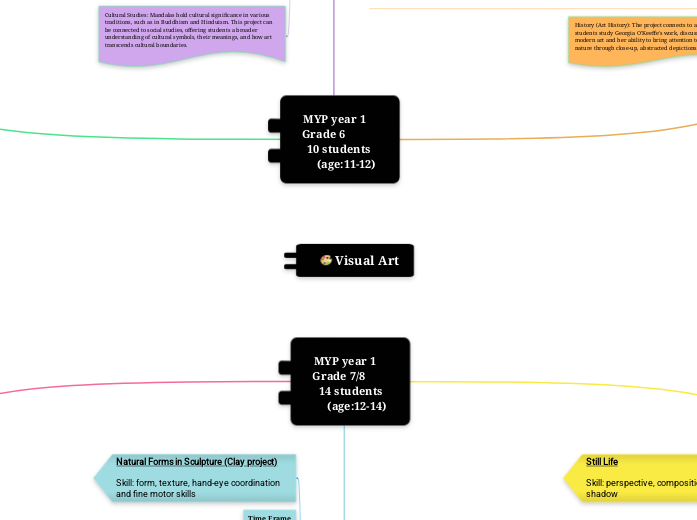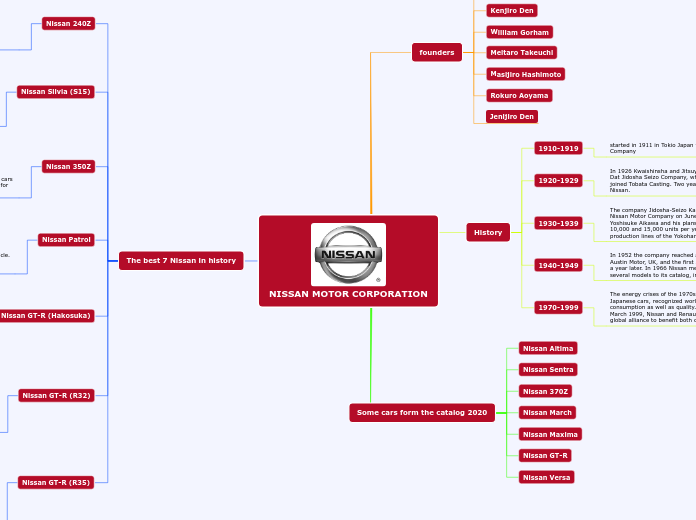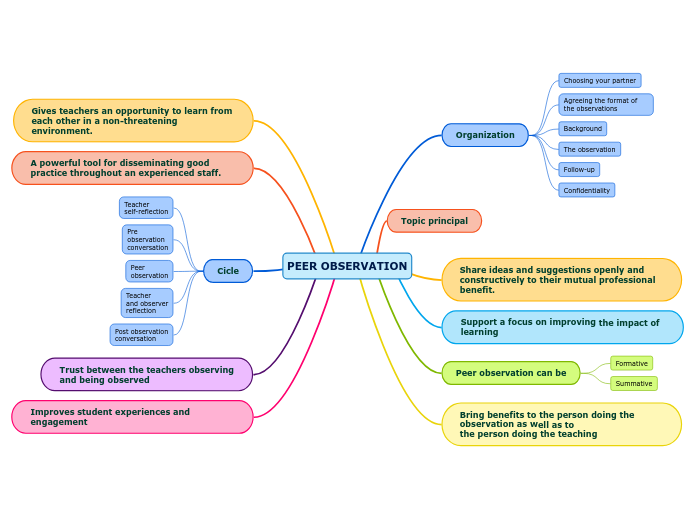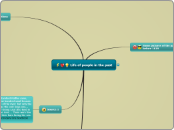MYP year 1 Grade 7/8 14 students (age:12-14)
Science (Physics of Light): Understanding how light interacts with surfaces and how shadows are cast ties into lessons on the physics of light. Students explore concepts like reflection, refraction, and light sources as they observe the way light hits objects.
Student Learning Expectation
Students will investigate the history of still life art, identifying key artists and movements that have influenced the genre.
Students will enhance their observational skills by closely studying the shapes, textures, and colors of the objects in their still-life setup.
Students will develop proficiency in various artistic techniques, such as shading, blending, and color mixing, to effectively represent light and shadow.
Art Standards
Apply methods to overcome creative blocks. (VA:Cr1.1.8.a)
Demonstrate persistence in developing skills with various materials, methods, and approaches in creating works of art or design. (VA:Cr2.1.7.a) Reflect on and explain important information about personal artwork in an artist statement or another format. (VA:Cr3.1.7.a) Based on criteria, analyze and evaluate methods for preparing and presenting art. (VA:Pr4.1.7.a) Interpret art and generate meanings through describing and analyzing feelings, subject matter, formal characteristics, artmaking approaches, and contextual information and identify key concepts. (VA:Re8.1.7.a) Individually or collaboratively create visual documentation of places and times in which people gather to make and experience art or design in the community (VA:Cn10.1.7.a)
MYP Objectives
Learning About Art: Students will study the history and evolution of still life in art, examining how artists use composition, lighting, color, and texture to convey mood and meaning in still life pieces.
Creating: Students will engage in hands-on activities to create their own still life artworks. They will practice techniques in drawing, painting, or mixed media, focusing on aspects such as composition, perspective, and the interplay of light and shadow.
MYP Criteria
Criterion A: Investigating
i. investigate a movement(s) or genre(s) in their chosen arts discipline, related to the statement of inquiry
ii. describe an artwork or performance from the chosen movement(s) or genre(s).
Criterion C: Creating/Performing
i. create or perform an artwork.
Still Life
Skill: perspective, composition, light and shadow
Social-Emotional Learning (SEL): Working with clay can be therapeutic, allowing students to express themselves creatively while developing patience and persistence. Sculpting encourages focus and mindfulness as they engage with the tactile experience of shaping natural forms.
Student Learning Expectation
Students will demonstrate proficiency in various clay sculpting techniques (pinch, coil, slab) to effectively create and manipulate their chosen forms.
Students will enhance their understanding of artistic processes, develop their creative skills, and foster a deeper appreciation for the connections between art and the natural world.
Art Standards
Apply methods to overcome creative blocks. (VA:Cr1.1.8.a)
Demonstrate persistence in developing skills with various materials, methods, and approaches in creating works of art or design. (VA:Cr2.1.7.a)
Apply visual organizational strategies to design and produce a work of art, design, or media that clearly communicates information or ideas. (VA:Cr2.3.7.a) Reflect on and explain important information about personal artwork in an artist statement or another format. (VA:Cr3.1.7.a) Based on criteria, analyze and evaluate methods for preparing and presenting art. (VA:Pr4.1.7.a) Interpret art and generate meanings through describing and analyzing feelings, subject matter, formal characteristics, artmaking approaches, and contextual information and identify key concepts. (VA:Re8.1.7.a) Analyze how response to art is influenced by understanding the time and place in which it was created, the available resources, and cultural uses. (VA:Cn11.1.7.a)
MYP Objectives
Learning Through Art: Students will develop essential skills in clay modeling, and learning techniques such as pinch, coil, and slab construction. They will engage in experimentation, discovering how to manipulate clay to achieve desired shapes and textures. Throughout the process, students will reflect on their artistic decisions and the significance of their chosen natural forms, fostering a deeper understanding of the connection between art and nature.
Creating: Students will engage in the creative process, beginning with research and sketching to identify a natural form that resonates with them. They will experiment with various sculpting techniques—such as pinch, coil, and slab construction—to build their sculptures, focusing on how these methods can capture the essence of their chosen forms.
Natural Forms in Sculpture (Clay project)
Skill: form, texture, hand-eye coordination and fine motor skills
Language Arts:
Self-Expression and Reflection: Students can write an artist's statement or reflection on why they chose a specific color and how it represents them. This encourages personal expression and improves their writing and communication skills as they articulate their artistic choices.
Student Learning Expectation
Students will explore the concept of monochromatic color schemes and how different shades, tints, and tones can convey emotion and depth.
Art Standards
Apply methods to overcome creative blocks. (VA:Cr1.1.8.a)
Develop criteria to guide making a work of art or design to meet an identified goal. (VA:Cr1.2.7.a)
Demonstrate persistence in developing skills with various materials, methods, and approaches in creating works of art or design. (VA:Cr2.1.7.a) Reflect on and explain important information about personal artwork in an artist statement or another format. (VA:Cr3.1.7.a) Interpret art and generate meanings through describing and analyzing feelings, subject matter, formal characteristics, artmaking approaches, and contextual information and identify key concepts. (VA:Re8.1.7.a) Analyze how response to art is influenced by understanding the time and place in which it was created, the available resources, and cultural uses. (VA:Cn11.1.7.a)
MYP Objectives
Learning about the art: investigate and describe how art forms and their elements are used and applied.
Learning through the art: practice various techniques and processes, and apply these skills to produce artworks that reflect their understanding and intentions.
MYP Criteria
Criterion A: Investigating
i. investigate a movement(s) or genre(s) in their chosen arts discipline, related to the statement of inquiry
ii. describe an artwork or performance from the chosen movement(s) or genre(s).
Criterion B: Developing
i. practically explore ideas to inform the development of a final artwork or performance
ii. present a clear artistic intention for the final artwork or performance in line with the statement of inquiry.
Monochromatic self-portrait painting (Tempera paint/ oil pastel)
Skill: contrast and emphasis, value and tone
MYP year 1 Grade 6 10 students (age:11-12)
Add a key element related to the main idea. Try to use descriptive words.
Trimester 3
History (Art History): The project connects to art history as students study Georgia O'Keeffe's work, discussing her impact on modern art and her ability to bring attention to the beauty of nature through close-up, abstracted depictions.
Student Learning Expectation
Students will research and articulate key aspects of Georgia O’Keeffe’s life, her artistic philosophy, and the cultural context of her work, demonstrating an understanding of her influence on modern art.
Students will engage in the creative process by generating and developing original ideas for their artworks based on their observations of natural forms, inspired by O’Keeffe.
Art Standards
VA: Cr1.1.6.a Combine concepts collaboratively to generate innovative ideas for creating art.
VA: Cr2.1.6.a Demonstrate openness in trying new ideas, materials, methods, and approaches in making works of art and design.
VA:Cr2.2.6.a Explain environmental implications of conservation, care, and cleanup of art materials, tools, and equipment.
VA:Cr3.1.6.a Reflect on whether personal artwork conveys the intended meaning and revise accordingly.
VA:Re7.1.6.a Identify and interpret works of art or design that reveal how people live around the world and what they value.
VA:Re7.2.6.a Analyze ways that visual components and cultural associations suggested by images influence ideas, emotions, and actions.
VA:Cn11.1.6.a Analyze how art reflects changing times, traditions, resources, and cultural uses.
MYP Objectives
Learning about the art: investigate the life and works of Georgia O’Keeffe, understanding her contributions to American modernism and the significance of her art in relation to nature and abstraction.
Creating: Using oil pastels, students will create their own compositions inspired by O’Keeffe, focusing on color and form.
MYP Criteria
Criterion A: Investigating
i. investigate a movement(s) or genre(s) in their chosen arts discipline, related to the statement of inquiry
ii. describe an artwork or performance from the chosen movement(s) or genre(s).
Criterion C: Creating/Performing
i. create or perform an artwork.
Close up flowers ( Georgia O’Keefe )
Medium- oil pastel
Skill: composition, light and shadow, organic shape, layering and blending
Trimester 2
Cultural Studies: Mandalas hold cultural significance in various traditions, such as in Buddhism and Hinduism. This project can be connected to social studies, offering students a broader understanding of cultural symbols, their meanings, and how art transcends cultural boundaries.
Student Learning Expectation
Students will create original artworks using various techniques and media, demonstrating an understanding of the elements and principles of design.
Students will explore the historical and cultural significance of different art movements and styles, connecting these to their own artistic practice. Students will apply principles of symmetry and geometric design in their mandalas, enhancing their understanding of composition and visual balance.
Art Standards
VA: Cr1.2.6.a Formulate an artistic investigation of personally relevant content for creating art.
VA: Cr2.2.6.a Explain the environmental implications of conservation, care, and cleanup of art materials, tools, and equipment.
VA: Re7.1.6.a Identify and interpret works of art or design that reveal how people live around the world and what they value.
VA: Re8.1.6.a Collaboratively interpret art and generate meanings through describing and analyzing feelings, subject matter, formal characteristics, artmaking approaches, and contextual informationn.
VA: Cn11.1.6.a Analyze how art reflects changing times, traditions, resources, and cultural uses.
MYP Objectives
Learning through the art: study the elements of design—such as symmetry, pattern, and color-through hands-on creation of mandalas, students enhance their technical skills with various mediums, including drawing, painting, or digital tools.
Creating: Each mandala can reflect the artist’s thoughts, feelings, and experiences, As they complete their mandalas, students reflect on their artistic choices, the process of creation, and the final outcome, fostering a deeper understanding of their own artistic voice.
MYP Criteria
Criterion B: Developing
i. practically explore ideas to inform the development of a final artwork or performance
ii. present a clear artistic intention for the final artwork or performance in line with the statement of inquiry.
Criterion C: Creating/Performing
i. create or perform an artwork.
Mandala Design
Medium- markers, watercolor Skill: Symmetry, balance, repetition and pattern
Trimester 1
Math: The grid drawing technique directly links to mathematical concepts such as measurement, symmetry, and spatial reasoning. Students apply math skills as they divide their reference images and drawings into equal parts, enhancing their understanding of ratios and proportions.
Student Learning Expectation
Students will investigate the life and works of Chuck Close, focusing on his contributions to photorealism and his unique approach to self-portraiture.
They will create a self-portrait using the grid technique that reflects their personal identity.
Art Standards
VA: Cr1.1.6.a Combine concepts collaboratively to generate innovative ideas for creating art. VA:Cr2.1.6.a Demonstrate openness in trying new ideas, materials, methods, and approaches in making works of art and design.
VA:Cr2.2.6.a Explain environmental implications of conservation, care, and cleanup of art materials, tools, and equipment.
VA:Cr3.1.6.a Reflect on whether personal artwork conveys the intended meaning and revise accordingly
VA:Re8.1.6.a Collaboratively interpret art and generate meanings through describing and analyzing feelings, subject matter, formal characteristics, artmaking approaches, and contextual information.
MYP Objectives
Learning about the art: investigate and describe how art forms and their elements are used and applied.
Learning through the art: practice various techniques and processes, and apply these skills to produce artworks that reflect their understanding and intentions.
MYP Criteria
Criterion A: Investigating
i. investigate a movement(s) or genre(s) in their chosen arts discipline, related to the statement of inquiry
ii. describe an artwork or performance from the chosen movement(s) or genre(s).
Criterion B: Developing
i. practically explore ideas to inform the development of a final artwork or performance
ii. present a clear artistic intention for the final artwork or performance in line with the statement of inquiry.
Time Frame
8 Weeks
Self-portrait (grid drawing) Medium- pencils Skill: Proportions, shading, tone and value
Visual Art
Write the main idea of your bubble map. It can be anything from an idea, a concept, an object, a person, a holiday, etc.









